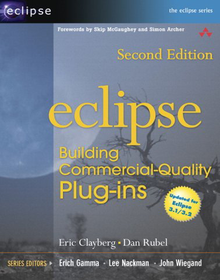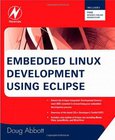Eclipse
Building Commercial-Quality Plug-ins
2nd Edition

Book Details:
| Publisher: | Addison-Wesley Professional |
| Series: | Addison Wesley |
| Author: | Eric Clayberg |
| Edition: | 2 |
| ISBN-10: | 032142672X |
| ISBN-13: | 9780321426727 |
| Pages: | 864 |
| Published: | Apr 01 2006 |
| Posted: | Nov 19 2014 |
| Language: | English |
| Book format: | CHM |
| Book size: | 20.11 MB |
Book Description:
A new edition of this title is available, ISBN-10: 0321553462 ISBN-13: 9780321553461 "I'm often asked, 'What are the best books about Eclipse?' Number one on my list, every time, is Eclipse: Building Commercial-Quality Plug-ins. I find it to be the clearest and most relevant book about Eclipse for the real-world software developer. Other Eclipse books focus on the internal Eclipse architecture or on repeating the Eclipse documentation, whereas this book is laser focused on the issues and concepts that matter when you're trying to build a product."-- Bjorn Freeman-BensonDirector, Open Source Process, Eclipse Foundation "As the title suggests, this massive tome is intended as a guide to best practices for writing Eclipse plug-ins. I think in that respect it succeeds handily. Before you even think about distributing a plug-in you've written, read this book."-- Ernest Friedman-HillSheriff, JavaRanch.com "Eclipse: Building Commercial-Quality Plug-ins was an invaluable training aid for all of our team members. In fact, training our team without the use of this book as a base would have been virtually impossible. It is now required reading for all our developers and helped us deliver a brand-new, very complex product on time and on budget thanks to the great job this book does of explaining the process of building plug-ins for Eclipse."-- Bruce Gruenbaum "This is easily one of the most useful books I own. If you are new to developing Eclipse plug-ins, it is a 'must-have' that will save you lots of time and effort. You will find lots of good advice in here, especially things that will help add a whole layer of professionalism and completeness to any plug-in. The book is very focused, well-structured, thorough, clearly written, and doesn't contain a single page of 'waffly page filler.' The diagrams explaining the relationships between the different components and manifest sections are excellent and aid in understanding how everything fits together. This book goes well beyond Actions, Views, and Editors, and I think everyone will benefit from the authors' experience. I certainly have."-- Tony Saveski "The authors of this seminal book have decades of proven experience with the most productive and robust software engineering technologies ever developed. Their experiences have now been well applied to the use of Eclipse for more effective Java development. A must-have for any serious software engineering professional!"-- Ed Klimas "Just wanted to also let you know this is an excellent book! Thanks for putting forth the effort to create a book that is easy to read and technical at the same time!"-- Brooke Hedrick "The key to developing great plug-ins for Eclipse is understanding where and how to extend the IDE, and that's what this book gives you. It is a must for serious plug-in developers, especially those building commercial applications. I wouldn't be without it."-- Brian Wilkerson "If you're looking for just one Eclipse plug-in development book that will be your guide, this is the one. While there are other books available on Eclipse, few dive as deep as Eclipse: Building Commercial-Quality Plug-ins." -- Simon Archer Eclipse has established itself as a dominant force in the application-development space. Key to the success of Eclipse is the ability of developers to extend its functionality using plug-ins. This new edition of Eclipse: Building Commercial-Quality Plug-ins is the definitive, start-to-finish guide to building commercial-quality Eclipse plug-ins, with an emphasis on adding the sophistication and polish that paying customers demand. The book provides both a quick introduction to using Eclipse for new users and a reference for experienced Eclipse users wishing to expand their knowledge and improve the quality of their Eclipse-based products. Revised to take advantage of pure Eclipse 3.1 and 3.2 APIs, this widely praised bestseller presents detailed, practical coverage of every aspect of plug-in development and specific solutions for the challenges developers are most likely to encounter. All code examples, relevant API listings, diagrams, and screen captures have been updated. Some Eclipse concepts--such as actions, views, and editors--have not changed radically, but now have additional functionality and capabilities. Other areas, such as the Eclipse plug-in infrastructure, have changed drastically due to the Eclipse shift towards an OSGi-based infrastructure. This edition is fully updated to address these new advances for Eclipse developers. Includes a quick introduction to Eclipse for experienced Java programmers Serves as a systematic reference for experienced Eclipse users Introduces all the tools you need to build Eclipse and Rational plug-ins Explains the Eclipse architecture and the structure of plug-ins and extension points Offers practical guidance on building Eclipse user interfaces with SWT and JFace Shows how to use change tracking, perspectives, builders, markers, natures, and more Covers internationalization, help systems, features, and branding This book is designed for anyone who wants a deep understanding of Eclipse, and every experienced developer interested in extending Eclipse or the Rational Software Development Platform.
Download Link:
Related Books:
Eclipse in Action
A Guide for the Java Developer
Eclipse is a new open-source, Java-based, extensible development platform designed for nothing in particular but everything in general. Because of its roots, it is currently most popular as a Java integrated development environment (IDE). Eclipse ships with plugins for writing and debugging Java code. Additional plugins for more advanced Java development, such as JSP/servlets, are available from third parties. This book provides a thorough guide to using Eclipse features and plugins effectively in the context of real-world Java development. Realistic examples demonstrate how to use Eclipse effectively to build, test and debug applications using the tools provided by Eclipse and other third-party open source plugins. The reader will learn how to use p...
SWT/JFace in Action
GUI Design with Eclipse 3.0
Covering Eclipse's new capability for building graphical user interfaces with version 3.0, the Standard Widget Toolkit (SWT) and JFace, this guide demonstrates how these award-winning tools have received broad support for creating desktop applications. Theory and practical examples reveal how to build GUIs that combine the look and feel of native interfaces with the platform independence of Java. This guide also shows how SWT makes use of the widgets provided by the operating system and describes how these components can be associated with events, containers, and graphics. With this knowledge, programmers can build fully featured user interfaces that communicate directly with the underlying platform. JFace's ability to simplify and organize the proce...
Embedded Linux Development Using Eclipse
The Eclipse environment solves the problem of having to maintain your own Integrated Development Environment (IDE), which is time consuming and costly. Embedded tools can also be easily integrated into Eclipse. The C/C++CDT is ideal for the embedded community with more than 70% of embedded developers using this language to write embedded code. Eclipse simplifies embedded system development and then eases its integration into larger platforms and frameworks. In this book, Doug Abbott examines Eclipse, an IDE, which can be vital in saving money and time in the design and development of an embedded system. Eclipse was created by IBM in 2001 and then became an open-source project in 2004. Since then it has become the de-facto IDE for embedded developers....
2007 - 2021 © eBooks-IT.org



